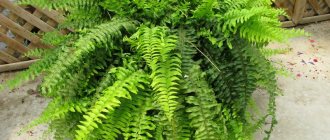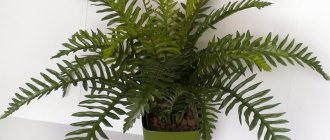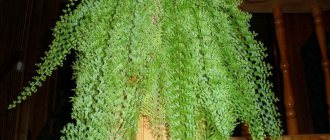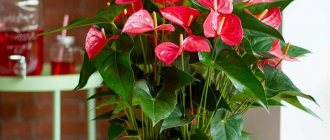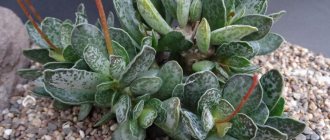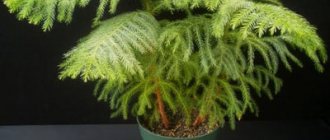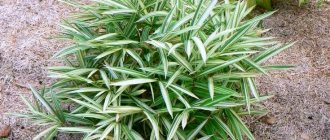Ferns and moss are the most ancient representatives of the plant world.
They outlived the dinosaurs and observed the evolution of man. They have been decorating nature for many centuries. Also, this type of plant has become a favorite among humans and has been grown as a home crop for centuries.
Ferns attract gardeners with their curly, rugged leaves, unpretentious care, and ability to grow in the shade.
In the natural environment there are more than 11 thousand ferns. Only a few dozen varieties are suitable for home cultivation. Tropical and subtropical species are suitable for indoor conditions. For streets, views from temperate latitudes.
Reproduction
Sporangia are located on the underside of the leaf, collected in groups (soruses). The sori are covered from above by a veil (ring). The spores are dispersed when the wall of the sporangium ruptures, and the ring, detached from the thin-walled cells, behaves like a spring. The number of spores on one plant reaches tens, hundreds of millions, sometimes billions.
Fern leaf from the underside
On moist soil, the spores germinate into a small green heart-shaped plate a few millimeters in size. This is a prothallus (gametophyte). It is located almost horizontally to the surface of the earth, attached to it by rhizoids. The prothalla is bisexual. On the underside of the prothallus, female and male reproductive organs are formed (male - antheridia, female - archegonia).
Fertilization occurs in an aquatic environment (during dew, rain or under water).
Male gametes - sperm swim up to the eggs, penetrate inside and the gametes fuse.
Fertilization occurs, resulting in the formation of a zygote (fertilized egg).
From the fertilized egg, a sporophyte embryo is formed, consisting of a haustorium - a leg with which it grows into the tissue of the prothallus and consumes nutrients from it, an embryonic root, a bud, and the first leaf of the embryo - “cotyledons”.
Over time, a fern plant develops from the shoot.
Fern development diagram
Thus, the gametophyte
ferns exist independently of the sporophyte and are adapted to living in humid conditions.
Sporophyte
is the entire plant that grows from a zygote - a typical land plant.
Ferns belong to the oldest group of plants, which existed long before the appearance of flowering vegetation and have survived to this day. Today, fern is one of the popular plants for landscape design. In this topic, we will consider the propagation of ferns at home, as well as their varieties and development.
Sheet
– the most visible part of the fern. In all species, except aquatic ones, the leaves are first curled into a spiral, and unfold as they develop. Their final sizes and shapes vary widely. They are usually pinnate. From the common petiole, as, for example, in nephrolepis, small leaves extend on both sides. They are often divided into leaflets of the second and third orders (this is observed, in particular, in mutant forms of the same fern). Common fronds in greenhouses of the genus Cyathaea
,
Cibotium
and
Angiopteris
reach a length of 5.5 m with a width of more than 90 cm. A representative of the tropical family Schizea dwarf, which reaches Newfoundland, resembles a small cereal with leaves twisted in a corkscrew.
Another unusual example is the genus Vittaria
, whose representatives have long, cord-like, fringed leaves hanging from the branches of the saber palmate.
The leaves of the liana-like fern Lygodium
twine around support plants, and in some tropical species of the Gleicheniaceae family the long forked leaves are covered with sharp spines and form almost impenetrable thickets.
Also on topic:
PLANT ANATOMY
Typically, the leaf of ferns serves both for photosynthesis and for the formation (on its underside) of reproductive structures - spores. They are formed in sporangia, which are either open or protected by the curved edge of the leaf or special outgrowths of its epidermis - spathes (indusia). In some species, sporangia are formed only on specialized leaves in the middle part of the frond (Clayton's celandine), at its apex (for example, in the acrostic polygonum) or on specially shaped entirely sporiferous leaves, which sometimes lose the ability to photosynthesize.
Types and varieties of ferns
There are a huge number of groups and varieties of fern.
Asplenium.
Known for its love of rocky surfaces. Forms a separate family. The description is as follows: round, leathery leaf blades on thin branches. The most famous two types: wall and northern. The first is often found on the walls of old stone buildings. It grows mainly in rock crevices. Northern loves the rocky places of northern Europe and Asia.
Woodsia.
Belongs to the Asplenieceae family. A low-growing fern, characterized by “fluffy” foliage - thin leaves grow from a small root, from which smaller leaves diverge in two directions. It has several varieties (Elbe, multi-row), which differ in the size and density of the leaves.
Kochedyzhnik.
Also belongs to the Asplenium family. This variety has about 200 varieties. Of these, the most famous are female, Chinese-reddish (with red veins). Description: tall shrub with delicate, light leaf feathers.
Multi-row.
Like previous groups, it is part of the Asplenium family. It differs from the previous ones in the width of its leafy branches and its love for the dense shade of wooded areas. The following varieties are known: Brown's multirow, tripartite, and bristle.
Orlyak.
Belongs to the Cyathea family. Popular for its unpretentiousness - varieties of this group are found on all continents of our planet: tundra, wasteland, wooded thickets. It is not found except in the desert and steppes. It differs from other varieties in the huge size of its leaf branches - up to one and a half meters.
Osmunda.
Forms his own family. One of the most ancient types of ferns. In ancient times they grew on all continents, but today they are found only in the Caucasus, in the forests of East Asia and North America. The following varieties are known: Asian, Clayton, royal. Loves a little shade and marshy areas.
Many indoor plants have such a decorative appearance that they seem artificial. If you want to have a real “corner of the forest” at home, you should acquire one of the most ancient plants, the ancestors of which date back to the dinosaurs - fern. Its external attractiveness and undemanding nature have earned this plant the love of flower growers. And now we have an indoor fern, caring for it at home is not difficult.
Where can I buy?
You can buy ferns in greenhouses, specialized flower shops or on Internet portals. The cost of a plant depends on its variety and size:
- nephrolepis boston and asplenium nesting height 25 cm - about 800 rubles;
- nesting asplenium height 65 cm – 5,500 rubles;
- Nephrolepis sublime, height 40 cm – 2,100 rubles;
- nephrolepis vital and sonata – 3,200 rubles.
Fern perfectly decorates any interior. But it will look healthy and lush only with constant proper care and the creation of suitable conditions. Only with good lighting, timely watering and frequent spraying will the openwork fronds of the flower delight with their beauty and grace.
Indoor fern: care at home
The most common fern in Russian homes is Nephrolepis. It easily adapts to room conditions and looks impressive. Rich green color, elegant rosette, carved leaves - up to half a meter long. Even if the fern is the only plant in the house, after a while it will grow so much that it will look like a piece of the garden and will begin to attract the attention of guests. But in order for the fern to thrive, a number of conditions must be met.
Soil requirements
It would seem, what could be the care for a fern growing in the forest shade? Who waters it, fertilizes it, carefully grows it? But no, there are demands, and quite a lot.
First of all, it is worth remembering that it is the forest soil that flower growers go for, trying to provide their plants with the best soil.
What kind of land is in the forest? Fertile, peaty and light. That is, there are enough nutrients in it, and the water does not stagnate. If you have purchased a fern and are going to replant it, then you can add a little rotted foliage or old pine needles to the soil purchased in the store. No matter how much the fern loves dampness, stagnation of moisture is strictly contraindicated for it. Store-bought soil “cakes” over time and becomes dense, so adding foliage will be very helpful.
Transfer
The fern plant is a fast-growing plant, and therefore it is replanted every year at a young age. It is recommended to replant adult specimens every 2–3 years. Fern transplantation is carried out in the spring.
In order not to harm the plant, it is advised to replant it into a larger pot using the transshipment method. During transplantation, the base of the rosette of leaves should not be buried in the ground.
The soil from the roots of indoor flowers is not cleaned so as not to damage the fragile roots. An exception is a disease of an indoor flower, in which it is necessary to detect damaged roots and remove them.
The fern is sensitive to the transplantation procedure, and its recovery can take several months.
To transplant ferns, you can buy a ready-made soil substrate with an acidic environment in the store or prepare the soil yourself. To do this you need to take:
- leaf soil - 1 part;
- humus – 1 part;
- peat – 1 part;
- bone meal – 1/5 part.
You can use another primer containing:
- 3 parts each of leaf soil and peat;
- 2 parts of turf land;
- 1 part humus and sand each;
- 1/2 cup ash;
- a handful of sphagnum moss.
Basic methods
Every gardener knows that indoor flowers can be propagated by seeds, cuttings, shoots, bulbs, division of rhizomes and other equally popular methods. Not everyone knows how fern reproduction occurs. Let's figure out how and how ferns reproduce.
There are two types of ferns: asexual (sporophytes) and sexual (gametophytes). In home floriculture, sporophytes are grown, in which the leaf blade is usually curled into a spiral. Asexual reproduction of ferns can be carried out by dividing the bush, sowing spores, lateral shoots and brood buds.
So, we bring to your attention the most common methods of fern propagation among lovers of indoor flora.
Disputes
According to many gardeners, propagation of ferns by spores is one of the most complex and labor-intensive processes. On the inside of adult leaf blades you can find brownish dust - these are spores. The spores will serve as a kind of seeds for the propagation of a tropical flower.
Take a plastic bag and collect the spores in it. Pour a mixture of sand and crushed peat into a plastic container and distribute the spores evenly over the entire surface of the soil. Don't forget to moisten the soil well. To create a favorable microclimate, the container must be covered with glass.
After 1–1.5 months, the first shoots will appear in the form of thick, bright green moss. As soon as the first leaves begin to hatch, you can open the container.
Young plants can be planted when three leaves are formed on each stem.
Dividing the bush
It will not be difficult to propagate a fern by dividing the bush if you first familiarize yourself with the advice and help of experienced gardeners. Before you start replanting an indoor flower, you should carefully examine it. In order for the bush to be divided into several fragments, each part must have a root system and 2-3 rosettes. There is no point in dividing a bush with one rosette, since single rosettes do not take root.
Upon completion of the division of the rhizome, each fragment is planted in a separate flower pot. Don't forget to monitor soil moisture and air temperature. For quick and good rooting, it is necessary to adhere to a temperature regime in the range of +18…+22 °C. Over-dried soil, low air humidity, too low or, conversely, high air temperature in the room will lead to the death of the transplanted ferns.
Vegetatively
Vegetative methods include propagation by lateral buds and shoots. But these methods of growing indoor flowers are not suitable for all varieties of fern. For example, propagation by brood buds is often used in the process of growing bladderwort, adiantum, doryopteris digitata, etc.
How to grow fern from brood buds, you ask? Let's consider this method step by step.
Carefully remove the buds on which roots have formed from the leaves. Place the collected material in a special container covered with glass. It is important to maintain a high level of humidity inside and an air temperature of about +24 °C. It is recommended to replant into separate containers only when the young shoots are well established and new leaves begin to form on them.
The shoots, which are long arrows on the leaves of the fern, are also used for propagation. Take a container with nutritious soil, place it next to the flower, bend the shoot to the soil and fix it.
It is necessary to separate the shoot from the mother plant after 1–1.5 months, when its roots have formed.
Ferns (Polypodiophyta)
, or
pteridophytes
, are spore-bearing terrestrial plants with strongly dissected, feathery leaves. They live on land in shady places, some in water. They spread by spores. They reproduce asexually and sexually. Fertilization in ferns occurs only in the presence of water.
In shady forests and damp ravines, ferns grow - herbaceous plants, and less often - trees, with large, strongly dissected leaves.
Ferns are widespread throughout the globe. They are most numerous and diverse in Southeast Asia. Here, ferns completely cover the soil under the forest canopy and grow on tree trunks.
Ferns grow both on land and in water. Most are found in moist, shady areas.
All ferns have a stem, roots and leaves. The strongly dissected leaves of ferns are called fronds. The stem of most ferns is hidden in the soil and grows horizontally (Fig. 80). It is unlike the stem of most plants and is called a rhizome.
Side shoots
Some species, for example, nephrolepis, have not only leaves, but also long leafless rhizomatous tendrils that act as both roots and lateral shoots.
When the whiskers fall into water, they suck it in, feeding the plant. You can also root them and get new young ferns. To root a side shoot, place pots or a container with moistened soil near an adult plant (or, for starters, a glass of water).
The fern tendrils are buried shallowly in the ground or immersed in water . For successful rooting, the soil should always be moist, but not wet, and the temperature should not fall below 18ºC.
Usually after 3-4 weeks the tendrils take root and begin to produce the first leaves. But young plants cannot be separated from the mother until they grow 3 leaves. After this they are ready to live independently.
Fern propagation
Spore plants differ from seed plants in many properties associated with reproduction. For example, in seed plants, the seeds are already fertilized when they fall into the ground, and a plant similar to the mother specimen immediately grows from them. This is not the case with ferns. Spores, which in a large number of fern species are formed under the green leaves, fall into the ground and develop into small green sprouts that are completely different from the mother plant. These shoots are called gametophytes. Gametophytes are female and male, and from them special cells, gametes, are formed in the ground. Male gametes combine with female ones, and at the site of their union a new form of fern begins to form, which is called a sporophyte.
Gametophytes are very small in size, and we do not see them in nature. What we notice in forests, or what is sold as an ornamental plant, is already the sporophytic phase of the fern. Sporophytes are often perennial. In hot climatic zones of the world, sporophytes are evergreen, but in temperate and more northern zones they shed their terrestrial green part in winter.
Ferns are distributed virtually throughout the globe, from deserts to swamps, rice fields and brackish ponds. They are most diverse in tropical rainforests. There they are represented by both tree-like forms (up to 25m in height) and herbaceous and epiphytic forms (growing on tree trunks and branches). There are species of ferns only a few millimeters long.
Features of the plant
Ferns are one of the most ancient plants on our planet.
Ferns grow in different climates and natural environments - in meadows and swamps, in forests, even on trees. But they are most common in the tropics. And it is the tropical varieties that have taken root in home floriculture. There are also frost-resistant species. Gardeners happily grow them in their garden plots.
All types of ferns consist of two parts: roots and openwork, feathery, arched leaves called fronds. Most plants have pinnately dissected leaf blades, but there are species with entire leaves of various shapes and sizes.
Ferns are mysterious and enigmatic plants that are mentioned in many legends. According to one of them, the fern blooms once a year - on the night of Ivan Kupala. Despite the legend, the plant does not produce flowers, fruits or seeds. Ferns reproduce by spores, like mushrooms, mosses and algae.
The fern has a characteristic feature: the plant is very hardy in nature, but may not survive at home even with proper care and the creation of optimal conditions. Plants are indicators of air purity: when exposed to a polluted and dusty atmosphere, fern leaves quickly wither and die.
Fern purifies the air and has healing properties, helps with bleeding, eczema, and abscesses, but at the same time, the fern rhizome is poisonous, and decoctions must be prepared strictly following the recipe.
Horsetails - structure
Horsetails are represented mainly by fossil forms. They arose during the Devonian and flourished in the Carboniferous period, reaching a wide variety of forms - up to giants 13 m high.
Modern horsetails number about 32 species and are represented by small forms - no more than 40 cm in height. They are found from the tropics to the polar regions, with the exception of Australia, and can live in both wet and dry areas. Some species have silicon deposits in the epidermis, which gives them a rough appearance.
Reproduction and development of horsetails
The sporophyte of horsetails consists of a horizontally branched underground stem - a rhizome, from which thin, branching roots and articulated aboveground stems extend. Some lateral branches of the rhizome are capable of forming small tubers with a supply of nutrients.
Horsetail propagation
The stem contains numerous vascular bundles arranged in a ring around the central cavity. On the stems, as well as on the rhizome, nodes are clearly visible, giving them a segmented structure.
A whorl of secondary branches extends from each node. The leaves are small, wedge-shaped, also arranged in whorls, covering the stem in the form of a tube. Photosynthesis occurs in the stem.
In addition to assimilating stems, horsetail also has unbranched, spore-bearing shoots of brown color, at the ends of which sporangia develop, collected in spikelets. Spores form in them. After the spores spill out, the shoots die off and are replaced by green branching (vegetative, summer) shoots.
Moss mosses - structure
Moss mosses were widespread in the late Devonian and Carboniferous periods. Many of them were tall tree-like plants. At present, a small number of species (about 400) have been preserved compared to the past - all of these are small plants - up to 30 cm in height. In our latitudes they are found in coniferous forests, less often in swampy meadows. The bulk of club mosses are inhabitants of the tropics.
Our common species is the club moss. It has a stem creeping along the ground, from which needle-branched side shoots extend vertically upward. Its leaves are thin, flat, arranged in a spiral, densely covering the stem and side branches. The growth of club mosses occurs only at the growing point, since there is no cambium in the stem.
Annual moss - photo
Reproduction of club mosses
At the top of the stem there are special leaves - sporophylls, collected in a strobile. Outwardly, it resembles a pine cone.
A germinating spore produces a germ (gametophyte), which lives and develops in the ground for 12-20 years. It has no chlorophyll and feeds on fungi (mycorrhiza). The change of sexual and asexual generations in horsetails and mosses occurs in exactly the same way as in ferns.
Fossil ferns formed thick layers of coal. Hard coal is used as fuel and raw material in various industries. Gasoline, kerosene, flammable gas, various dyes, varnishes, plastics, aromatics, medicinal substances, etc. are obtained from it.
The meaning of ferns, horsetails and mosses
Modern pteridophytes play a significant role in the formation of plant landscapes on Earth. In addition, people use horsetails as a diuretic and as an indicator of soil acidity. Due to the rigidity of the stems, associated with silicon deposits in the cell walls, horsetails were used for polishing furniture and cleaning dishes.
Moss moss spores are used in medicine as a powder, and male shieldweed is used as an anthelmintic. They are used to treat tobacco addiction, alcoholism and eye diseases. Some species of fern-like plants are bred as ornamental plants (adiantum, asplenium, nephrolepis).
Since the gametophyte of club mosses develops very slowly (12-20 years), these plants should be protected.
- Author: Maria Sukhorukikh
Rate this article:
- 5
- 4
- 3
- 2
- 1
(0 votes, average: 0 out of 5)
Share with your friends!
